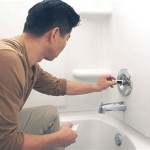How To Uninstall a NuTone Bathroom Fan
Replacing a bathroom fan can significantly improve ventilation, reduce moisture buildup, and even decrease energy costs. While professional installation is always an option, uninstalling an existing NuTone bathroom fan is often a manageable task for the average homeowner with some basic tools and a commitment to safety. This article provides a detailed guide on how to safely and effectively uninstall a NuTone bathroom fan.
Before commencing any electrical work, it's paramount to prioritize safety. This means disconnecting the power supply to the bathroom fan circuit at the main electrical panel. Locate the corresponding circuit breaker responsible for the bathroom in question and switch it to the 'OFF' position. To confirm that the power is indeed off, use a non-contact voltage tester to check the wires connected to the fan. It is crucial this step is not skipped under any circumstances. Working with electricity presents inherent risks, and failure to de-energize the circuit could result in severe injury or even death. Furthermore, ensure the area around the fan is clear of any obstructions, and use a stable ladder or step stool to reach the fan housing. Safety glasses should be worn to protect the eyes from debris that may fall during the disassembly process.
The typical NuTone bathroom fan installation involves a housing unit secured to the ceiling joists, the fan motor assembly and blower wheel within the housing, and wiring connecting the fan to the electrical circuit. Properly uninstalling the fan requires a systematic approach that addresses each of these components in a safe and controlled manner. This process necessitates a few common tools, including a screwdriver (Phillips and flathead), wire strippers, wire connectors, a non-contact voltage tester, safety glasses, gloves, and a ladder or step stool.
Key Point 1: Disconnecting the Electrical Wiring
The first critical step in uninstalling a NuTone bathroom fan is safely disconnecting the electrical wiring. Start by removing the fan cover. This can be achieved by either gently squeezing the sides of the cover to release it from its clips or by unscrewing any visible screws that secure it to the housing. Once the cover is removed, the fan motor assembly will be visible. Carefully detach the motor assembly from the housing. Many models have screws or clips holding it in place. Consult the specific model documentation if needed.
With the motor assembly removed, the wiring connections will be accessible. Before touching any wires, double-check with the non-contact voltage tester to ensure the power is completely off, even after disconnecting the breaker. This serves as a crucial secondary safety measure. Carefully note the configuration of the wires before disconnecting them. Typically, there will be a black (hot) wire, a white (neutral) wire, and a green or bare copper (ground) wire. Taking a clear picture with a smartphone or drawing a diagram can be helpful for re-wiring the new fan later.
Using wire strippers, carefully disconnect each wire from the existing wire connectors. If the wires are directly connected with wire nuts, unscrew the wire nuts and separate the wires. Avoid cutting the wires too short, as this may make it difficult to connect them to the new fan. Once the wires are disconnected, cap each exposed wire end with a new wire connector to prevent accidental contact and ensure safety. Tuck the capped wires back into the electrical box.
It's important to reiterate the significance of proper wire handling. Never force wires or pull on them excessively. Damaged wiring can create a fire hazard. If the existing wiring insulation appears brittle or damaged, it may be necessary to consult with a qualified electrician to replace the wiring before installing the new fan. Furthermore, adhering to local electrical codes is essential to ensure that the installation meets safety standards.
Key Point 2: Removing the Fan Housing
After disconnecting the electrical wiring, the next step involves removing the fan housing from the ceiling. The method of attachment can vary depending on the age and model of the NuTone fan. Some housings are directly screwed into the ceiling joists, while others are suspended by metal mounting brackets or straps. The housing is what contains the motor and blower fan and is crucial to remove in order to replace it after.
If the housing is screwed directly into the joists, locate the screws holding it in place. Using a screwdriver, remove all the screws. A power drill with a screwdriver bit may be helpful for speeding up this process, but caution should be exercised to avoid stripping the screw heads. If the housing is attached with mounting brackets, examine how the brackets are connected to the housing and the joists. Some brackets may be screwed in, while others may be nailed or stapled. Use the appropriate tools to remove the brackets, taking care not to damage the ceiling. In some cases, it may be necessary to cut the brackets with a metal cutting tool if they are difficult to remove.
When removing the housing, be prepared for it to be heavier than it looks. It's often helpful to have a second person assist in supporting the housing as the last screws or brackets are removed. This prevents the housing from falling and potentially damaging the ceiling or causing injury. Once the housing is free, carefully lower it to the ground. Dispose of the old housing properly, following local recycling guidelines if possible.
Before installing the new fan housing, inspect the opening in the ceiling. Ensure that the joists are in good condition and that there are no exposed wires or debris. It may be necessary to reinforce the joists if they are weak or damaged. Clean the area thoroughly to remove any dust or debris that may have accumulated over time. Addressing any structural issues at this stage will ensure a secure and stable mounting for the new fan.
Key Point 3: Dealing with Ductwork and Ventilation
Most bathroom fans are connected to ductwork that vents the moist air to the outside of the house. Disconnecting and reconnecting the ductwork is a crucial part of the fan uninstall and install process. The ductwork is what removes the humid air from the bathroom and takes it outside.
Before removing the fan housing, locate the ductwork connection. This is typically a flexible or rigid duct connected to the fan housing with clamps or tape. Loosen the clamp or carefully remove the tape securing the duct to the housing. If aluminum tape was used, it can require some force to remove. Gently slide the duct off the fan housing. If the duct is rigid, there may be screws or other fasteners holding it in place.
Inspect the ductwork for any damage or obstructions. If the duct is old or deteriorated, it may be necessary to replace it. Clean the ductwork to remove any dust or debris that may have accumulated inside. Ensure that the ductwork is properly insulated to prevent condensation and heat loss. If the ductwork isn’t insulated, the temperature change inside the duct can cause condensation.
When installing the new fan, ensure that the ductwork is properly connected and sealed to the fan housing. Use new clamps or aluminum tape to secure the duct to the housing. Make sure the connection is airtight to prevent air leaks. Air leaks will lower the efficiency of the fan and cause some of the damp air to stay within the bathroom, instead of going outside. Ensure the ductwork is properly supported to prevent it from sagging or becoming disconnected. Properly installed and maintained ductwork is essential for effective bathroom ventilation.
After completing the above three key points, the NuTone bathroom fan should be fully uninstalled. The subsequent steps would involve installing the new fan, which involves reversing the removal process, carefully connecting the wiring, securing the new housing, and properly connecting the ductwork. Always consult the manufacturer's instructions for the new fan to ensure proper installation. If unsure about any aspect of the installation process, it is recommended to consult with a qualified electrician.
Furthermore, consider the proper disposal methods for the old fan. Many of the fan's components, such as the motor and metal housing, may be recyclable. Check with local recycling centers for specific guidelines. Disposing of the fan responsibly helps minimize environmental impact.
Finally, regular maintenance of bathroom fans is crucial for ensuring optimal performance and longevity. Clean the fan blades and housing periodically to remove dust and debris. Check the ductwork for any obstructions or damage. Lubricate the motor if necessary. By properly maintaining the fan, it can provide years of reliable service and help maintain a healthy and comfortable bathroom environment.

Mastering The Basics How To Remove Your Nutone Bathroom Fan Cover With Ease

How To Remove Broan Nutone Fan Assembly

Broan Nutone Bath Fan Model 765h80l Disassembly Repair Help

Mastering The Basics How To Remove Your Nutone Bathroom Fan Cover With Ease

Not Sure How To Remove Old Bathroom Fan Install New One Doityourself Com Community Forums
How To Remove A Nutone Bathroom Fan Light Cover Quora

How To Remove Broan Bhfled80 Bathroom Fan Heater Assembly And Trouble Shoot

How To Clean Replace Light Broan Model 678 Exhaust Fan

Replacing A Bathroom Fan Cover Short

Can T Get The Grill Off Nutone Fan Light Doityourself Com Community Forums
Related Posts







